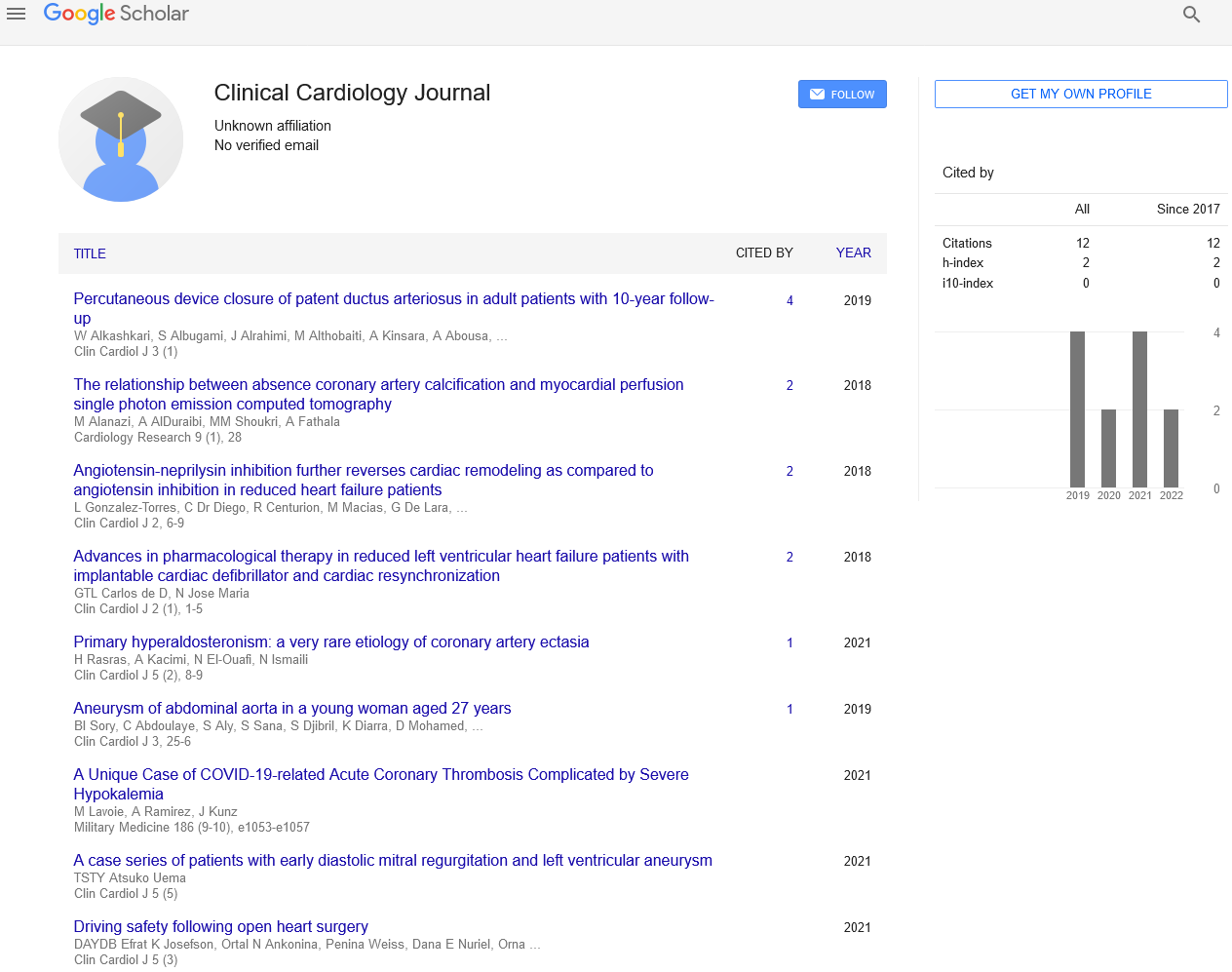A note on SARS-CoV-2 and cardiovascular disease
Received: 08-Nov-2021 Accepted Date: Nov 22, 2021; Published: 29-Nov-2021
Citation: Nishiga M. A note on SARS-CoV-2 and cardiovascular disease. Clin Cardiol J 2021;5(6):1-1.
This open-access article is distributed under the terms of the Creative Commons Attribution Non-Commercial License (CC BY-NC) (http://creativecommons.org/licenses/by-nc/4.0/), which permits reuse, distribution and reproduction of the article, provided that the original work is properly cited and the reuse is restricted to noncommercial purposes. For commercial reuse, contact reprints@pulsus.com
Opinion
The coronavirus disease 2019 (COVID-19) pandemic, which was caused by the severe acute respiratory syndrome coronavirus 2 (SARS-CoV-2) virus, has resulted in millions of confirmed cases and deaths around the world. Rapid and large-scale testing is critical in patient management and slowing disease spread, hence efficient diagnostic instruments are in great demand. This study examines current SARS-CoV-2 detection technologies in clinical laboratories, as well as breakthroughs in molecular, antigenbased, and immunological point-of-care testing, as well as recent sensor and biosensor device developments. The importance of specimen collection time and kind, as well as issues such as illness prevalence, setting, and procedures, are emphasised. The mechanisms of action of the various approaches, as well as their application breadth and known performance characteristics, are given in detail. The use of diagnostic imaging tools and biomarkers for measuring COVID-19 or monitoring disease severity or consequences is also covered. While the SARS-CoV-2 literature is continually expanding, this overview emphasises some of the most interesting events that occurred during the pandemic, as well as the lessons learned.
Exploring a diverse set of approaches for identifying SARS-CoV-2 will assure continuing diagnostic support for clinicians, public health, and infection prevention and control during this pandemic, as well as provide guidance for future pandemic preparedness. The entrance receptor for acute respiratory distress syndrome coronavirus-2 (SARS-CoV-2), which causes Coronavirus Disease-2019 (COVID-19) in people, is angiotensin-converting enzyme 2 (ACE2). ACE-2 is a type I transmembrane metallocarboxypeptidase that is found in vascular endothelium, alveolar type 2 lung epithelial cells, renal tubular epithelial cells, testes Leydig cells, and the gastrointestinal system. The interaction between host cells and the SARS-CoV-2 spike (S) protein is mediated by ACE2. ACE2, on the other hand, is not simply a SARS-CoV-2 receptor; it also serves as a homeostatic regulator of the reninangiotensin system (RAS), which is critical for both the cardiovascular and immunological systems. As a result, ACE2 serves as a vital link between SARS-CoV-2 infection, cardiovascular disease (CVD), and immune system. SARS-CoV-2 susceptibility appears to be closely linked to ACE2 availability, which is influenced by genetics, age, gender, and comorbidities.
COVID-19 causes severe respiratory distress syndrome (ARDS) and multiorgan failure because to an unregulated and overwhelming immunological response. Patients with CVDs have a higher COVID-19 mortality rate, despite lower ACE2 expression on the cell surface. This is likely due to an imbalance between the ADAM metallopeptidase domain 17 (ADAM17) protein (which is required for cleavage of the ACE-2 ectodomain, resulting in increased ACE2 shedding) and the TMPRSS2 protein (which is required for spike glycoprotein priming). Treatment interruption of ACE inhibitors and Angiotensin II Receptor Blockers (ARBs) in patients with chronic comorbidities appears to be justifiable to yet. The availability of COVID-19 vaccines allows researchers to investigate the effects of different COVID-19 vaccines on ACE2 in patients receiving ACEi/ARB therapy. Coronavirus disease 2019 (COVID-19) is a pandemic with historic implications for the cardiovascular health of millions of people who survive infection around the world.
The etiologic agent of COVID-19, severe acute respiratory syndromecoronavirus 2 (SARS-CoV-2), can infect the heart, vascular tissues, and circulating cells via ACE2, the host cell receptor for the viral spike protein. Acute cardiac damage is a common extra-pulmonary symptom of COVID-19, and it can have long-term repercussions. The clinical symptoms of cardiovascular involvement, putative direct SARS-CoV-2 and indirect immune response pathways affecting the cardiovascular system, and implications for patient care after recovery from acute COVID-19 infection are discussed in this update. Coronavirus disease 2019 (COVID-19), caused by a coronavirus strain known as severe acute respiratory syndrome coronavirus 2 (SARS-CoV-2), has spread over the world, affecting billions of people. SARS-CoV-2 shares several biological properties with SARS-CoV, the zoonotic virus that caused the 2002 severe acute respiratory syndrome outbreak, including the cell entrance system, which is triggered by the viral spike protein binding to angiotensin-converting enzyme-2.
A link between COVID-19 and cardiovascular illness has also been discovered in clinical investigations. COVID-19 appears to be connected to worse outcomes and an increased risk of death in individuals with pre-existing cardiovascular illness, despite the fact that COVID-19 can cause myocardial damage, arrhythmia, acute coronary syndrome, and venous thromboembolism. Patients with COVID-19 and concomitant cardiovascular disorders are increasingly concerned about potential drug– disease interactions. The present state of knowledge of COVID-19, from basic mechanisms to clinical views, with a focus on COVID-19’s interaction with the cardiovascular system. We can increase our understanding of the potential mechanisms behind COVID-19 by combining our knowledge of the virus’s biological properties with clinical results, paving the door for the development of prophylactic and therapeutic remedies. Seven coronaviruses (CoVs) have been confirmed to infect humans to date, with three extremely deadly varieties emerging in the twenty-first century.
The newest member of this family, severe acute respiratory syndrome coronavirus 2 (SARS-CoV-2), was discovered in China’s Hubei region near the end of 2019. Since then, this unique coronavirus has spread around the world, triggering a pandemic; the virus’s respiratory sickness is known as coronavirus disease 2019 (COVID-19). Asymptomatic to mild respiratory tract infections and influenza-like sickness to severe disease with lung injury, multi-organ failure, and death are all possible clinical presentations. Although SARS-CoV-2 is thought to replicate in the lungs, infected patients often report other symptoms, implying involvement of the gastrointestinal tract, heart, circulatory system, kidneys, and other organs; hence, the question of whether COVID-19 is a respiratory or systemic illness arises. The goal of this review is to compile existing data on SARS-CoV-2 replication in various tissues in both patients.





